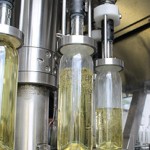 Well, we just finished another round of bottling! Thanks to everyone who came out to help and check out the mobile bottling line.
Well, we just finished another round of bottling! Thanks to everyone who came out to help and check out the mobile bottling line.
Bottling our wine is always a big event. We only do it twice a year, and it is the last piece of the winemaking puzzle. It is a long journey from grape to bottle and it is always so satisfying seeing the finished product that we’ve spent so much time nurturing reach the last step before we share it with all of you.
For those who haven’t seen the process, we’ll explain.
We have been working with the team at Old Woolam Custom Bottling for the last five years. They travel all over the Midwest and bottle for small wineries who do not have their own bottling line. As you can imagine, they are very expensive to maintain and require a great deal of space.
Old Woolam’s entire line is inside a trailer that parks next to our production facility. We run our hoses out and hook them up, then unload bottles, capsules, corks and labels. Once the wine starts pumping, the line starts moving! First the bottles are washed and sanitized, then filled with nitrogen to displace any oxygen inside. Then they are filled with wine and sealed with a cork. A foil capsule drops onto the top of the bottle and a fast-spinning cylinder moves over it and seals it tight. Each bottle is then sent through the labeling machine for a front and back label before it’s inspected for quality. Then it’s headed back out of the trailer!
Over the course of two days, we bottled 18,968 bottles! That is A LOT of wine.
Here’s what we bottled:
2015 Urban Bianco
2015 Sauvingnon Blanc
2015 Viognier
2015 Urban White
2015 Urban Rose
2014 Mourvedre
2014 Urban Red
2014 Cabernet Franc
2014 Petit Verdot
This year was a bit different from past years, though. We decided to seal the Sauvignon Blanc, Urban Bianco and Urban Rose with screw caps! While the corks vs. screw caps debate is a heated one with several different opinions, we are of the belief that white wines benefit from screw cap tops. It allows zero oxygen to enter the bottle, so the wine is as fresh as the day we bottled. And since white wines should really be consumed within a year or two of bottling, the absence of a cork to aid in wine aging doesn’t really matter in this case.
Check back later for a more in-depth look at the benefits of corks and screw caps.
Now that all of our new white wines and several of our reds are bottled, we’ll give them some time to settle in the bottle. We call it “bottle shock.” When we filter and bottle the wine, we’re moving it around a lot and it needs time to calm down from all of the excitement. We’ll taste them on a weekly basis to determine when it is ready to share.
Look for upcoming release dates and release specials on our Facebook page. You can also sign up to receive email updates on upcoming wine releases and bottling dates by clicking here.
